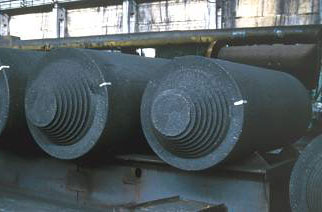Carbon electrodes are made of an allotrope of carbon called graphite. An allotrope is a fancy word for the structure of a material made of a single element, in terms of how the atoms in that structure organize themselves. In the case of graphite, it’s usually made of stacks of carbon atoms linked together in many hexagonal-shapes, bonded in turn to more hexagons to make a layer of graphene, one carbon atom thick. These graphene layers all stack up on top of each other with a fairly high level of uniformity, but, while graphene has incredible compressive strength for being one atom thick, the bonds between each sheet of graphene is far weaker, and fundamentally different, so graphite naturally occurs as a fairly soft and slightly brittle material. This form of ‘alpha-graphite’ is structurally different from the rhombohedrial-crystalline structure of ‘beta-graphite’, and the amorphous form of graphite glass, like most glasses, a random-close-packed structure.
Carbon electrode is not a metal, technically a semi-metal, but conducts electricity well enough under the right conditions to be useful as a conductor in some circumstances. It’s also chemically less susceptible to the degrading effects of some electrochemical reactions, being fairly chemically inert, and is far cheaper than using more chemically inert electrodes made from platinum-group metals, which range from more expensive than gold in the case of platinum, to more expensive than everything, in the case of most other platinum-group elements.

Graphite is also a refractory material, which means it performs well in extremely high-temperature environments, like the inside of electric arc furnaces, the business end of rockets, and the heat shields of re-entry vehicles. They are also used as refractory vessels for various metal-melting processes by themselves, and find use as electrodes in some welding, cutting, and electrical discharge machining applications. Graphite is also frequently used, sometimes mixed with a binder, as commutator brushes and electrical contacts in motors, relays and contactors, switches, and some generator designs, owing to their low hardness, high lubricity, resistance to damage caused by electrical arcs, and to arc melting that can cause metal electrical contacts to weld shut, which is bad. Graphute also has high resistance to the flow of electrical current, which makes them useful in the production of resistors and variable resistors.
Early light sources, rectifiers for alternating currents, speakers and microphones, battery cells, and lightning protection for buildings also used graphite. Battery cells that use carbon electrodes, along with zinc and an electrolyte- a liquid charge carrier, are still sold today for their low cost and long shelf-life. These usually indicate that they are carbon-zinc chemistry, or say industrial, or heavy-duty. Some 9-volt batteries use carbon electrodes, but most are made from batteries of 6 AAAA alkaline cells.
Prev: Graphite industry is one of the key industries in China
Next: Which is used as carbon electrodes in batteries?






